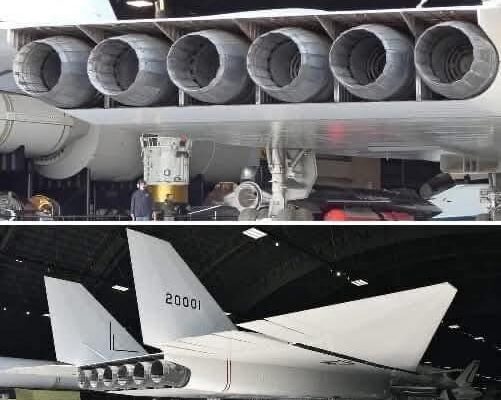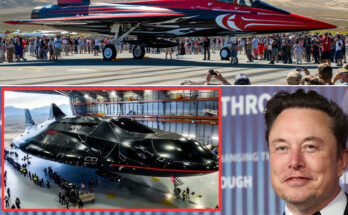
Few aircraft in history capture the imagination like the XB-70 Valkyrie, a plane that was as daring in its purpose as it was in its design. Built during the height of the Cold War, the XB-70 was conceived as a supersonic bomber capable of cruising at Mach 3—three times the speed of sound—while delivering nuclear payloads deep into enemy territory. It wasn’t just a bomber; it was a statement of technological dominance. Though its operational life was short-lived, the XB-70 remains an iconic symbol of ambition, ingenuity, and the relentless pursuit of progress.
The Birth of a Supersonic Dream

In the late 1950s, as tensions between the United States and the Soviet Union escalated, the U.S. Air Force sought a strategic bomber that could outrun enemy interceptors and missiles. The XB-70 Valkyrie, designed by North American Aviation, was their answer. The aircraft’s specifications were staggering:
- A maximum speed of Mach 3.1 (approximately 2,056 mph or 3,310 km/h).
- A cruising altitude of 70,000 feet, well above the reach of most Soviet defenses.
- A wingspan of 105 feet and a length of 185 feet, making it one of the largest bombers ever built.
The Valkyrie’s sleek, futuristic design was as much about performance as it was about aesthetics. The forward-swept wings and drooping wingtips, which folded downward at high speeds, were engineered to increase stability and reduce drag—a pioneering feature in aeronautics.
Pushing the Limits of Aeronautical Engineering

At the heart of the XB-70’s astonishing capabilities were its six General Electric YJ93 engines, each capable of producing 30,000 pounds of thrust with afterburners. These engines not only propelled the Valkyrie to Mach 3 but also made it the largest and heaviest aircraft to achieve such speeds.
The materials used in its construction were equally groundbreaking. The fuselage was primarily made of stainless steel honeycomb panels, which could withstand the intense heat generated during supersonic flight. At Mach 3, the skin temperature of the aircraft could exceed 600°F (315°C), making traditional aluminum alloys impractical.

Inside the cockpit, pilots were treated to an environment more akin to a spacecraft than a conventional plane. Advanced instrumentation, a fully pressurized cabin, and protective suits for high-altitude operations highlighted the Valkyrie’s cutting-edge approach to design.
The Valkyrie in Action

Although the XB-70 was primarily intended as a nuclear bomber, it quickly became apparent that its true value lay in research and development. By the time the first prototype flew in 1964, advancements in missile technology had rendered high-speed bombers vulnerable to surface-to-air missiles (SAMs). Instead, the Valkyrie pivoted to a new role as a research platform, providing invaluable data on supersonic flight and aerodynamics.
The first flight of the XB-70 took place on September 21, 1964, a moment that marked a new era in aviation. Over the next two years, the Valkyrie completed 83 test flights, pushing the boundaries of what was possible. These missions provided critical insights into high-speed flight dynamics, structural integrity, and thermal effects—knowledge that would influence future aircraft, including the Concorde and the SR-71 Blackbird.
A Tragic End
Despite its promise, the XB-70 program faced numerous challenges. Rising costs, changing defense priorities, and the increasing effectiveness of SAMs led to the cancellation of the Valkyrie’s bomber program. Of the two prototypes built, only one survives today.
The second prototype, AV-2, met a tragic fate on June 8, 1966. During a routine formation flight with other aircraft, a collision occurred with an F-104 Starfighter, resulting in the loss of the Valkyrie and the lives of two pilots. The incident marked the end of the XB-70’s active flight program but cemented its legacy as one of the most ambitious projects in aviation history.
The XB-70’s Legacy
Today, the sole surviving Valkyrie, AV-1, resides at the National Museum of the U.S. Air Force in Dayton, Ohio. This towering aircraft continues to draw thousands of visitors each year, standing as a testament to the ingenuity of its creators and the era that produced it. The Valkyrie’s influence can be seen in numerous aspects of modern aviation:
- Supersonic Transport: Data from the XB-70’s test flights informed the development of the Concorde, particularly in areas like thermal expansion and high-speed aerodynamics.
- Military Aviation: The Valkyrie’s research contributed to the development of high-speed reconnaissance aircraft like the SR-71 Blackbird.
- Advanced Materials: The stainless steel honeycomb panels used in the XB-70 paved the way for innovations in lightweight, heat-resistant materials.
An Awe-Inspiring Sight

For those lucky enough to witness it, the Valkyrie in motion is an unforgettable experience. Even today, the museum occasionally moves the aircraft out of its hangar for maintenance, offering a rare glimpse of its six massive postburners and imposing frame. At 185 feet long and weighing over 500,000 pounds, the XB-70 is as much a marvel of engineering as it is a work of art.
Get Ready for Takeoff
Want to be the first to know about the latest aircraft and fighter jet news? Our newsletter has you covered. Enter your email address below and get ready for takeoff.
When standing before the Valkyrie, one can’t help but imagine the awe it must have inspired during its first flights. The sight of such a massive aircraft hurtling through the sky at Mach 3 is a vivid reminder of the boundless possibilities of human innovation.
Fascinating Facts About the XB-70
- Speed Demon: At Mach 3, the Valkyrie could fly from New York to Los Angeles in just over an hour.
- Heat Shield: The aircraft’s stainless steel construction allowed it to endure temperatures that would have melted conventional aircraft.
- Innovative Wing Design: The drooping wingtips, which folded downward at high speeds, reduced drag and enhanced stability—a first in aviation.
- Record-Breaker: The Valkyrie remains the largest aircraft ever to achieve sustained supersonic flight.
- Limited Numbers: Only two prototypes were ever built, making the XB-70 one of the rarest aircraft in history.
Why the Valkyrie Matters

The XB-70 Valkyrie was more than just a bomber or a research platform; it was a bold experiment in pushing the limits of technology. It represented an era when the impossible seemed within reach and when innovation was pursued with fearless determination.
For aviation enthusiasts, the Valkyrie is a source of endless fascination. Its sleek design, groundbreaking technology, and dramatic story make it a cornerstone of aerospace history. As we look to the future of supersonic and hypersonic flight, the XB-70’s legacy serves as a reminder of what humanity can achieve when we dare to dream.
If you’re captivated by the story of this incredible aircraft, a visit to the National Museum of the U.S. Air Force is a must. Seeing the XB-70 Valkyrie up close is a humbling experience—a chance to stand in the shadow of a true marvel of engineering. And for those who want to dive deeper into its story, the museum’s archives are a treasure trove of information about one of the most ambitious aircraft ever built.
The Valkyrie’s story may have ended in the 1960s, but its spirit lives on, inspiring engineers, pilots, and dreamers to reach for the skies—and beyond.



